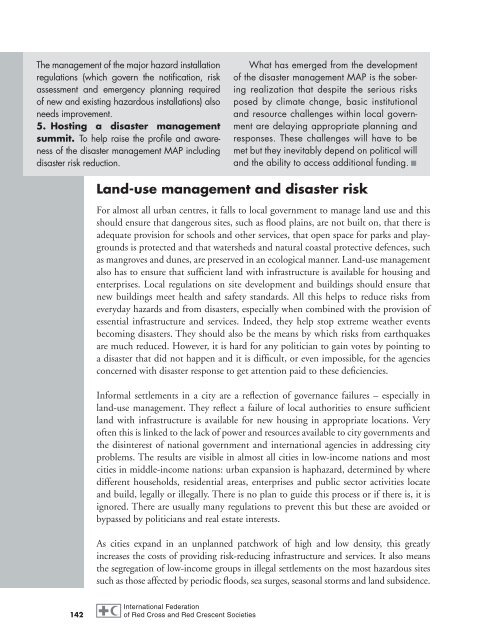World Disasters Report 2010 - International Federation of Red Cross ...
World Disasters Report 2010 - International Federation of Red Cross ...
World Disasters Report 2010 - International Federation of Red Cross ...
Create successful ePaper yourself
Turn your PDF publications into a flip-book with our unique Google optimized e-Paper software.
The management <strong>of</strong> the major hazard installation<br />
regulations (which govern the notification, risk<br />
assessment and emergency planning required<br />
<strong>of</strong> new and existing hazardous installations) also<br />
needs improvement.<br />
5. Hosting a disaster management<br />
summit. To help raise the pr<strong>of</strong>ile and awareness<br />
<strong>of</strong> the disaster management MAP including<br />
disaster risk reduction.<br />
142<br />
What has emerged from the development<br />
<strong>of</strong> the disaster management MAP is the sobering<br />
realization that despite the serious risks<br />
posed by climate change, basic institutional<br />
and resource challenges within local government<br />
are delaying appropriate planning and<br />
responses. These challenges will have to be<br />
met but they inevitably depend on political will<br />
and the ability to access additional funding.��<br />
Land-use management and disaster risk<br />
For almost all urban centres, it falls to local government to manage land use and this<br />
should ensure that dangerous sites, such as flood plains, are not built on, that there is<br />
adequate provision for schools and other services, that open space for parks and playgrounds<br />
is protected and that watersheds and natural coastal protective defences, such<br />
as mangroves and dunes, are preserved in an ecological manner. Land-use management<br />
also has to ensure that sufficient land with infrastructure is available for housing and<br />
enterprises. Local regulations on site development and buildings should ensure that<br />
new buildings meet health and safety standards. All this helps to reduce risks from<br />
everyday hazards and from disasters, especially when combined with the provision <strong>of</strong><br />
essential infrastructure and services. Indeed, they help stop extreme weather events<br />
becoming disasters. They should also be the means by which risks from earthquakes<br />
are much reduced. However, it is hard for any politician to gain votes by pointing to<br />
a disaster that did not happen and it is difficult, or even impossible, for the agencies<br />
concerned with disaster response to get attention paid to these deficiencies.<br />
Informal settlements in a city are a reflection <strong>of</strong> governance failures – especially in<br />
land-use management. They reflect a failure <strong>of</strong> local authorities to ensure sufficient<br />
land with infrastructure is available for new housing in appropriate locations. Very<br />
<strong>of</strong>ten this is linked to the lack <strong>of</strong> power and resources available to city governments and<br />
the disinterest <strong>of</strong> national government and international agencies in addressing city<br />
problems. The results are visible in almost all cities in low-income nations and most<br />
cities in middle-income nations: urban expansion is haphazard, determined by where<br />
different households, residential areas, enterprises and public sector activities locate<br />
and build, legally or illegally. There is no plan to guide this process or if there is, it is<br />
ignored. There are usually many regulations to prevent this but these are avoided or<br />
bypassed by politicians and real estate interests.<br />
As cities expand in an unplanned patchwork <strong>of</strong> high and low density, this greatly<br />
increases the costs <strong>of</strong> providing risk-reducing infrastructure and services. It also means<br />
the segregation <strong>of</strong> low-income groups in illegal settlements on the most hazardous sites<br />
such as those affected by periodic floods, sea surges, seasonal storms and land subsidence.

















